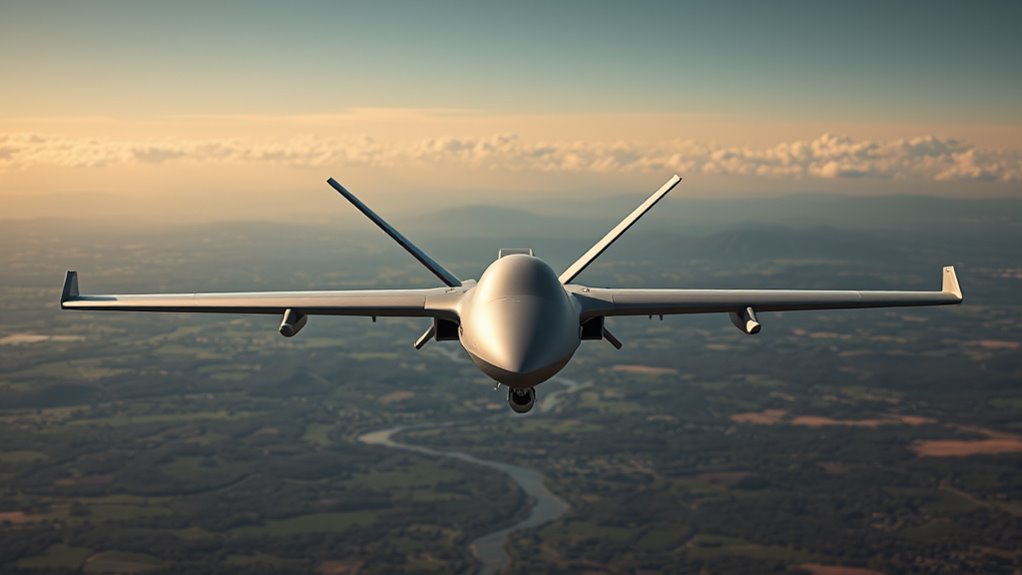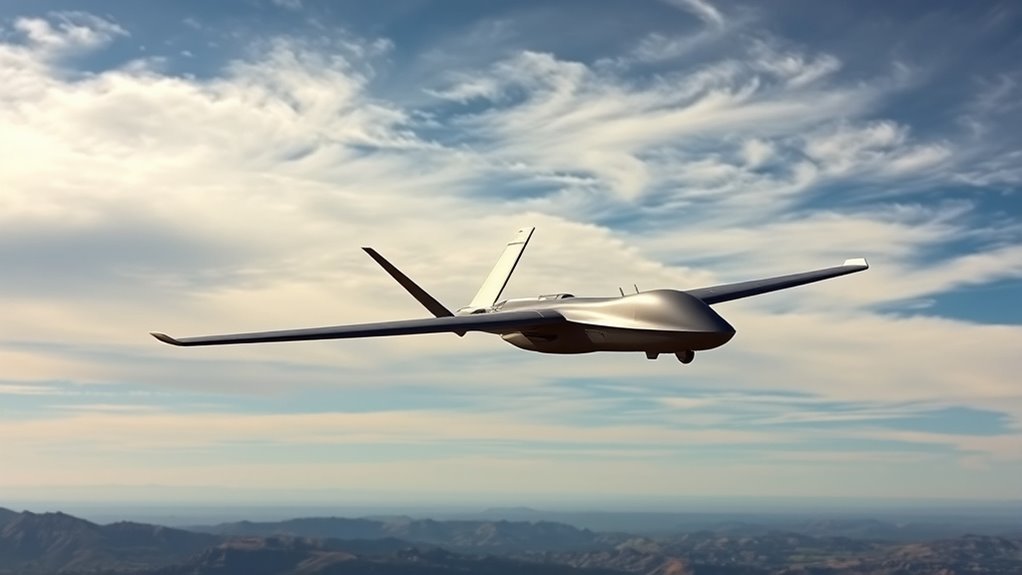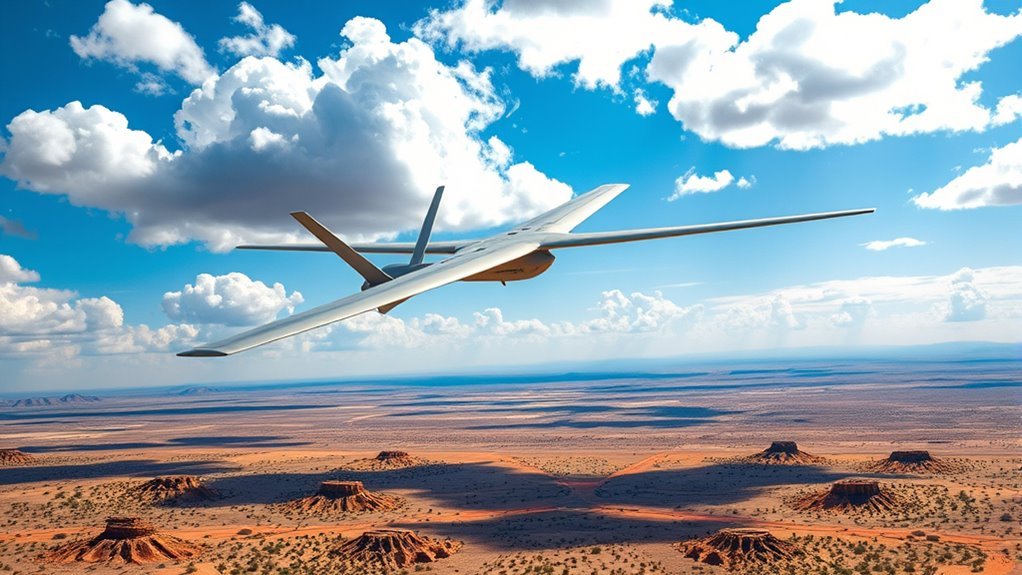Military drones vary considerably in their flight ranges, depending on the design and purpose. For instance, the MQ-1 Predator has a range of around 770 miles, while the MQ-9 Reaper can cover approximately 1,150 miles. The RQ-4 Global Hawk excels with a remarkable range of 12,300 miles, perfect for extended surveillance. Factors such as payload, battery capacity, and environmental conditions affect these ranges. Understanding these specifications can enhance your grasp of operational capabilities.
The Evolution of Military Drones

Since their inception, military drones have undergone significant transformation, evolving from rudimentary surveillance tools to sophisticated platforms capable of executing complex missions. In the early stages of drone history, these devices primarily served as aerial reconnaissance units, providing essential intelligence without risking human lives. As technology advanced, military applications expanded to include precision strikes and real-time data collection, enhancing operational capabilities. The integration of advanced sensors, artificial intelligence, and communication systems has further revolutionized how military forces utilize drones. Today, you see drones performing multi-faceted roles, from logistics support to battlefield surveillance, illustrating their crucial importance in modern warfare. This evolution reflects a broader trend towards automation and efficiency, aligning with the desire for strategic freedom and enhanced national security. Additionally, drones like Asylon’s advanced features exemplify how innovation drives the military’s commitment to reliable and scalable solutions. Aspects such as tactical camera quality have become increasingly vital to ensure effective and reliable operations in dynamic environments.
Types of Military Drones and Their Specifications

When evaluating military drones, it’s essential to understand the specifications that define their operational capabilities. Tactical UAVs are designed for close-range missions with specific payload limits, while long-range drones excel in endurance and reconnaissance. By examining these categories, you can better appreciate how each type meets distinct military needs.
Tactical UAV Specifications
Tactical UAVs, or Unmanned Aerial Vehicles, represent an essential component of modern military operations, designed for various roles including reconnaissance, surveillance, and combat. These drones come equipped with specialized tactical drone features tailored to specific UAV mission profiles. For instance, some models, like the Raven, are lightweight with a short range, perfect for on-the-ground troops needing immediate reconnaissance. Others, such as the Reaper, boast advanced sensors and armaments, extending their operational capabilities. Each UAV is engineered for unique environments, balancing payload capacity with flight endurance. You’ll find that understanding these specifications allows you to appreciate how tactical drones enhance situational awareness, enabling forces to make informed decisions swiftly and effectively.
Long-Range Drone Capabilities
As advancements in technology continue to reshape military operations, long-range drones have emerged as vital assets, offering unparalleled capabilities for both reconnaissance and strike missions. These unmanned aerial vehicles (UAVs) can operate at extended distances, often exceeding hundreds of miles without needing to return to base. Equipped with sophisticated sensors, they excel in long-range reconnaissance, providing real-time intelligence and surveillance over vast terrains. For instance, the MQ-9 Reaper can fly up to 1,150 miles with a flight ceiling of 50,000 feet, enabling effective engagement in diverse scenarios. Their ability to loiter for hours enhances mission effectiveness, allowing operators to gather essential data while minimizing risk. Ultimately, long-range drones redefine strategic operations, granting military forces unprecedented reach and flexibility.
Factors Affecting Drone Range

When evaluating drone range, you’ll find several critical factors at play. Battery capacity directly influences how far a drone can fly before needing to recharge, while weather conditions can considerably impact performance and range. Additionally, the weight of the payload must be considered, as heavier loads can reduce flight distance and efficiency. Effective power management is essential for optimizing energy consumption and maximizing flight distance. Furthermore, the integration of advanced technologies like AI-driven autonomy can enhance operational efficiency, thereby extending the effective range of military drones.
Drone Battery Capacity
Battery capacity plays an essential role in determining a military drone’s operational range. Factors like battery longevity and energy efficiency directly impact how far these drones can fly. Understanding these components helps you grasp the limitations and capabilities of drone technology.
| Factor | Description | Impact on Range |
|---|---|---|
| Battery Longevity | Duration of battery life under ideal conditions | Longer missions possible |
| Energy Efficiency | Efficiency of power usage during flight | Greater distance covered |
| Weight of Battery | Heavier batteries reduce total range | Limits operational capacity |
Optimizing these factors can greatly enhance a drone’s range, allowing for extended missions and improved tactical advantages in various scenarios.
Weather Conditions Impact
While military drones are designed for versatility and endurance, their operational range can be greatly affected by weather conditions. Adverse weather effects, such as high winds, heavy rain, or extreme temperatures, can considerably compromise flight stability. For instance, strong winds can lead to increased drag, reducing range and affecting control during maneuvers. Rain and snow can impair sensor visibility and increase weight, further limiting operational capabilities. Additionally, temperature extremes can impact battery performance, leading to reduced flight time. Understanding these factors is essential for optimizing drone missions, as they can dictate the feasibility of operations in various environments. Ultimately, effective planning must account for these weather-related challenges to guarantee mission success and operational efficiency.
Payload Weight Considerations
Although military drones are engineered for efficiency, the payload weight they carry plays an essential role in determining their operational range. Understanding payload optimization strategies is imperative, as excess weight can greatly impact flight performance. Here are some key factors to bear in mind:
- Weight Distribution Effects: Unevenly distributed payloads can affect stability and control.
- Payload Type: Different sensors and weapons have varying weights that influence overall capability.
- Battery Life: Heavier payloads usually require more power, reducing the drone’s range.
- Aerodynamic Design: Streamlined designs can mitigate some weight impacts, ensuring better efficiency.
Endurance and Flight Time of Military Drones
Understanding the endurance and flight time of military drones is essential for evaluating their operational effectiveness. Drone endurance directly influences mission capabilities, allowing for extended surveillance and reconnaissance. Typically, flight times can vary considerably based on design and mission profile.
| Drone Model | Endurance (Hours) |
|---|---|
| MQ-1 Predator | 24 |
| MQ-9 Reaper | 27 |
| RQ-4 Global Hawk | 34 |
| RQ-7 Shadow | 9 |
These figures highlight the importance of selecting the right drone for your specific mission needs. The longer a drone can stay airborne, the more freedom you’ll have to gather intelligence and respond to evolving situations on the battlefield.
Comparisons of Range Among Popular Military Drones
As military operations increasingly rely on unmanned aerial systems, comparing the range of popular military drones becomes essential for strategizing deployments. Understanding the range helps enhance drone design and operational efficiency. Here’s a quick comparison of some notable military drones:
- MQ-1 Predator: Range of around 770 miles, offering flexibility for reconnaissance missions.
- MQ-9 Reaper: Extends to 1,150 miles, providing an ideal balance between payload and range.
- Global Hawk: Impressive range of 12,300 miles, making it suitable for long-duration surveillance.
- Raven: Shorter range of about 6.2 miles, designed for tactical, close-support operations.
Each drone’s design reflects its intended mission, directly impacting its operational efficiency and range capabilities.
The Role of Communication Systems in Flight Range
While the range of military drones is primarily dictated by their design and fuel capacity, the effectiveness of communication systems plays an essential role in extending operational reach. You’ll find that communication latency can considerably impact the drone’s ability to maintain command and control at greater distances. As the drone flies farther, it may encounter signal degradation, leading to loss of data or control. This degradation can occur due to environmental factors or obstructions, making robust communication systems indispensable for reliable operations. An efficient communication link not only enhances situational awareness but also allows for real-time adjustments, ultimately maximizing the drone’s effectiveness. Consequently, understanding these systems is imperative for optimizing flight range and mission success.
Technological Advances Enhancing Drone Capabilities
Recent innovations in drone technology are substantially enhancing their operational capabilities, enabling military units to achieve greater efficiency and effectiveness in various missions. The integration of cutting-edge features is essential for adapting to complex environments. Key advancements include:
- Autonomous navigation: Drones can now navigate without human intervention, allowing for rapid deployment in dynamic situations. This capability mirrors the thermal imaging technology in emergency response, enabling swift identification of critical threats.
- Enhanced sensors: Improved imaging and detection technologies provide greater situational awareness and target identification.
- Extended battery life: Advances in energy efficiency enable longer flight durations and increased mission scope.
- Advanced data processing: Real-time data analysis facilitates quicker decision-making and operational responsiveness.
These technological strides empower military drones to perform a wider array of tasks while ensuring safety and precision in their operations. Additionally, the use of advanced AI integration in drone systems enhances operational efficiency and response times.
Strategic Implications of Drone Flight Range
The advancements in drone technology not only enhance operational capabilities but also greatly influence military strategy. You’ll find that extended flight ranges provide strategic advantages, enabling forces to conduct missions deep within enemy territory without risking personnel. This capability shifts the balance of power, as nations can project force from afar, complicating adversaries’ responses. Geopolitical considerations become paramount; countries with advanced drone fleets can deter aggression or conduct surveillance over vast areas, altering regional dynamics. The ability to strike swiftly and discreetly can undermine traditional military postures, creating a landscape where rapid, unmanned engagements become the norm. Consequently, understanding the implications of drone range is essential for maintaining strategic superiority and ensuring national security in an increasingly interconnected world. Furthermore, integrating thermal cameras with unmanned systems enhances detection and decision-making in dynamic defense scenarios. Additionally, the AeroVironment Puma is known for its superior flight endurance, providing extended operational capabilities in various missions.
Future Trends in Military Drone Development
As military needs evolve, future trends in drone development are likely to focus on enhanced autonomy, artificial intelligence integration, and improved stealth capabilities. These advancements will redefine how you perceive future warfare. Expect to see:
Future drone development will prioritize autonomy, AI, and stealth, transforming modern warfare and military strategies.
- Autonomous navigation systems that allow drones to operate with minimal human input. EHang’s user-centric autonomy highlights the trend of integrating advanced AI for seamless operation.
- AI-driven decision-making processes that enhance mission effectiveness and adaptability.
- Stealth technologies that reduce detection risks, allowing for covert operations.
- Swarming capabilities that enable multiple drones to coordinate in complex environments.
These innovations not only improve operational efficiency but also enhance strategic flexibility. As these technologies advance, you’ll witness a significant shift in military tactics and the role of drones in shaping modern conflict landscapes. Embracing these changes is vital for maintaining a competitive edge. Furthermore, the potential US ban on DJI may accelerate innovation in the drone sector, leading to new designs and features that empower military applications.
Frequently Asked Questions
What Are the Environmental Impacts of Military Drone Operations?
While drones offer precision, they also contribute to environmental pollution and wildlife disruption. You’ll find their operations can disturb ecosystems and habitats, posing significant risks to biodiversity, which contradicts the ideals of freedom and preservation.
How Do Military Drones Differ From Commercial Drones?
Military drones have advanced military capabilities, focusing on surveillance and combat, while commercial drones prioritize consumer use and recreational purposes. The drone technology differs greatly, with military models designed for endurance and tactical operations.
What Are the Legal Regulations Surrounding Military Drone Usage?
Steering through the skies, military compliance hinges on strict drone regulations, ensuring safety and accountability. You’ll find these laws shape operational boundaries, reflecting a balance between national security and the freedom of airspace utilization.
How Do Military Drones Impact Ground Troop Safety?
Military drones considerably enhance troop protection by providing real-time surveillance accuracy, allowing ground forces to identify threats before engagement. This advanced capability reduces risks, ensuring safer operations and better strategic decision-making in combat environments.
What Is the Cost Range for Military Drones?
The cost range for military drones varies considerably. Advanced drone technology can lead to high operational costs, often exceeding millions. You’ll find more affordable options, but they typically sacrifice capabilities or endurance in the field.

